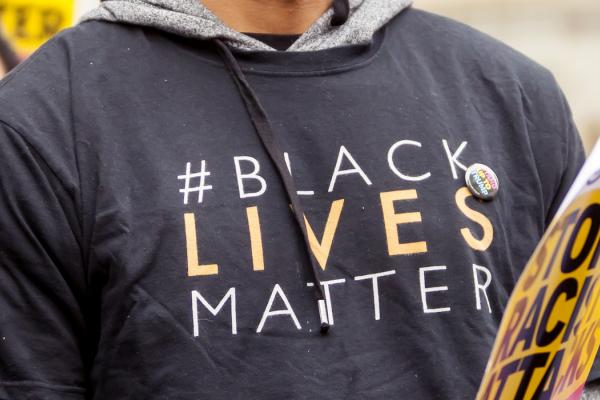I grew up in a Tulsan church tradition my family had embraced for generations that used music as a retreat from the troubles of this world.
My childhood pastor’s booming sermons lifted the congregation’s collective and individual consciousness. They were accented with a slap of the bass, a ringing of an organ, and the rousing chorus of an encouraged congregation. Midway through the service the choir would usually sing, with joy or melancholy, steeped in soulful triumph over consistent experiences with pain. These songs seemed to ring out through the neighborhoods of North Tulsa. These tones and improvisational licks would cause tears to flow, handholds to clasp a bit tighter, and congregants to momentarily leave behind the difficulties that awaited them after Sunday service.
As a kid, I never understood those tears — I never grasped the cause of the fervently loud responses, the clanging of cymbals, nor the impassioned banging of tambourines. I just accepted that something important was happening to these adults which was beyond my 10-year-old brain’s capacity to understand.
One of the most important fixtures of this weekly service was the organ. Joey Crutcher was our organ player, and his touch at the keyboard — an infusion of jazz, gospel, and R&B — was as familiar to me as the cadence of the liturgical exercise we affectionately knew as church. Our solemnity is expressed in tears of joy and groans of overcoming.
Joey, who died in 2014, was Terence Crutcher’s brother. Terence was shot by former Officer Betty Shelby on Sept. 16, 2016. The day the news broke, I couldn’t leave my Harvard Business School dorm. I was refreshing websites frantically trying to keep up with the news. In my head, nostalgic riffs of Joey’s artful piano playing competed with the tears I imagined from his mother. The cries of our community which, even before this incident, had etched on our faces and embedded in our hearts the trauma of living in a world that didn’t quite value the hue of our skin. Like the verses of most hymns seared into my head by years of childhood memorization, I recall the all-too-common refrain among black men, “that could’ve easily been me.” With each death, Terence included, that refrain replaces the encouraging tones of the popular, hymn “We Shall Overcome.”
I have driven down that now infamous street on which Terence was shot by Officer Shelby. I look — especially to eyes full of suspicion and fear — the same as Terrance.
James Baldwin wrote, “People are trapped in history and history is trapped in them.” Tulsa’s history of racial injustice has been so intertwined into the tapestry of the city and so engrained in its policy landscape that inequity has become the acceptable status quo. Our kids go to failing schools and highways separate us from the rest of the city. The shadow of racial injustice has unduly influenced Tulsa’s relationship with its black community, and within each black Tulsan is a long history of disappointment in the institutions meant to serve us.
During the early 20th century, North Tulsa was home to “Black Wall Street” or “Little Africa,” a black community representing one of the country’s highest concentrations of black success, charting its own course and reinvesting in itself.
But on May 30, 1921, an incident took place between a young black shoeshine boy and a young white female elevator operator. A simple tripping accident intentionally misinterpreted as assault provided the pretext for the next day’s terrible actions as aggrieved white residents launched an assault, razing Black Wall Street to the ground. Over 6,000 black residents were arrested, more than 800 admitted to hopsitals, and at least 300 people killed.
The fire set ablaze by angry white residents engulfed 1000 homes and black owned businesses destoyed. The elimination of hope that Little Africa once offered is the heavy anchor that black Tulsans carry with them daily. This once-booming district now holds mainly nostalgia and indefinitely deferred dreams.
When Tulsa’s black community sees Terence’s body on the news, we see another more recent, fatal incident of injustice. We see the streets which never fail to remind us of the tragedy of being black in Tulsa. Framing this incident within the shadows of Trayvon Martin or Eric Garner demonstrates the national expanse of the pervasive fragility of black life. Each second of every interaction with law enforcement can turn fatal.
But more deeply than that, framing Terence’s last gasp of life in the texture of local challenges shows the frailty of black Tulsa’s dream of equal treatment. We need to ensure Terence does not become another note on a scale of the pain felt by countless black and brown lives. It’s only been seven months and the voices of those affected by this history have been diminished.
But in this new presidential administration, we must, now more than ever, revisit these incidents. A new dissonant soloist with presidential powers has emerged. His jarring lyrics can routinely be found on Twitter at 3 a.m. He takes it as a given that that minorities are “living in hell” with nothing to lose. He has inadvertently framed black life as inherently worse off with little expectations for parity. The trappings of his office make for powerful acoustics that carry, leading a band aimed at silencing the unique sounds of black life.
The harsh dissonance of injustice has become the white noise we ignore. That white noise drowns out the importance of the place where Terence’s lifeless body laid and blots out the critical importance of how Terence’s race and place intersect. Police officers like Officer Shelby did not suddenly become more violent, they just ignore that race and place meet everywhere. Without visiting this history, we will never develop the empathy to stop the shots being fired, or stop families like the Crutchers — or mine — from becoming the latest to grieve.
Got something to say about what you're reading? We value your feedback!

